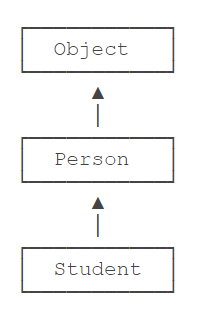在前面的章节中,我们已经定义了Person类:
class Person { private String name; private int age; public String getName() {...} public void setName(String name) {...} public int getAge() {...} public void setAge(int age) {...} }
现在,假设需要定义一个Student类,字段如下:
class Student { private String name; private int age; private int score; public String getName() {...} public void setName(String name) {...} public int getAge() {...} public void setAge(int age) {...} public int getScore() { … } public void setScore(int score) { … } }
仔细观察,发现Student类包含了Person类已有的字段和方法,只是多出了一个score字段和相应的getScore()、setScore()方法。
能不能在Student中不要写重复的代码?
这个时候,继承就派上用场了。
继承是面向对象编程中非常强大的一种机制,它首先可以复用代码。当我们让Student从Person继承时,Student就获得了Person的所有功能,我们只需要为Student编写新增的功能。
Java使用extends关键字来实现继承:
class Person { private String name; private int age; public String getName() {...} public void setName(String name) {...} public int getAge() {...} public void setAge(int age) {...} } class Student extends Person { // 不要重复name和age字段/方法, // 只需要定义新增score字段/方法: private int score; public int getScore() { … } public void setScore(int score) { … } }
可见,通过继承,Student只需要编写额外的功能,不再需要重复代码。
在OOP的术语中,我们把Person称为超类(super class),父类(parent class),基类(base class),把Student称为子类(subclass),扩展类(extended class)。
继承树
注意到我们在定义Person的时候,没有写extends。在Java中,没有明确写extends的类,编译器会自动加上extends Object。所以,任何类,除了Object,都会继承自某个类。下图是Person、Student的继承树:

Java只允许一个class继承自一个类,因此,一个类有且仅有一个父类。只有Object特殊,它没有父类。
类似的,如果我们定义一个继承自Person的Teacher,它们的继承树关系如下:

protected
继承有个特点,就是子类无法访问父类的private字段或者private方法。例如,Student类就无法访问Person类的name和age字段:
class Person { private String name; private int age; } class Student extends Person { public String hello() { return "Hello, " + name; // 编译错误:无法访问name字段 } }
这使得继承的作用被削弱了。为了让子类可以访问父类的字段,我们需要把private改为protected。用protected修饰的字段可以被子类访问:
class Person { protected String name; protected int age; } class Student extends Person { public String hello() { return "Hello, " + name; // OK! } }
因此,protected关键字可以把字段和方法的访问权限控制在继承树内部,一个protected字段和方法可以被其子类,以及子类的子类所访问,后面我们还会详细讲解。
super
super关键字表示父类(超类)。子类引用父类的字段时,可以用super.fieldName。例如:
class Student extends Person { public String hello() { return "Hello, " + super.name; } }
实际上,这里使用super.name,或者this.name,或者name,效果都是一样的。编译器会自动定位到父类的name字段。
但是,在某些时候,就必须使用super。我们来看一个例子:
public class Main { public static void main(String[] args) { Student s = new Student("Xiao Ming", 12, 89); } } class Person { protected String name; protected int age; public Person(String name, int age) { this.name = name; this.age = age; } } class Student extends Person { protected int score; public Student(String name, int age, int score) { this.score = score; } }
运行上面的代码,会得到一个编译错误,大意是在Student的构造方法中,无法调用Person的构造方法。
这是因为在Java中,任何class的构造方法,第一行语句必须是调用父类的构造方法。如果没有明确地调用父类的构造方法,编译器会帮我们自动加一句super();,所以,Student类的构造方法实际上是这样:
class Student extends Person { protected int score; public Student(String name, int age, int score) { super(); // 自动调用父类的构造方法 this.score = score; } }
但是,Person类并没有无参数的构造方法,因此,编译失败。
解决方法是调用Person类存在的某个构造方法。例如:
class Student extends Person { protected int score; public Student(String name, int age, int score) { super(name, age); // 调用父类的构造方法Person(String, int) this.score = score; } }
这样就可以正常编译了!
因此我们得出结论:如果父类没有默认的构造方法,子类就必须显式调用super()并给出参数以便让编译器定位到父类的一个合适的构造方法。
这里还顺带引出了另一个问题:即子类不会继承任何父类的构造方法。子类默认的构造方法是编译器自动生成的,不是继承的。
向上转型
如果一个引用变量的类型是Student,那么它可以指向一个Student类型的实例:
Student s = new Student();
如果一个引用类型的变量是Person,那么它可以指向一个Person类型的实例:
Person p = new Person();
现在问题来了:如果Student是从Person继承下来的,那么,一个引用类型为Person的变量,能否指向Student类型的实例?
Person p = new Student(); // ???
测试一下就可以发现,这种指向是允许的!
这是因为Student继承自Person,因此,它拥有Person的全部功能。Person类型的变量,如果指向Student类型的实例,对它进行操作,是没有问题的!
这种把一个子类类型安全地变为父类类型的赋值,被称为向上转型(upcasting)。
向上转型实际上是把一个子类型安全地变为更加抽象的父类型:
Student s = new Student();
Person p = s; // upcasting, ok
Object o1 = p; // upcasting, ok
Object o2 = s; // upcasting, ok
注意到继承树是Student > Person > Object,所以,可以把Student类型转型为Person,或者更高层次的Object。
向下转型
和向上转型相反,如果把一个父类类型强制转型为子类类型,就是向下转型(downcasting)。例如:
Person p1 = new Student(); // upcasting, ok Person p2 = new Person(); Student s1 = (Student) p1; // ok Student s2 = (Student) p2; // runtime error! ClassCastException!
如果测试上面的代码,可以发现:
Person类型p1实际指向Student实例,Person类型变量p2实际指向Person实例。在向下转型的时候,把p1转型为Student会成功,因为p1确实指向Student实例,把p2转型为Student会失败,因为p2的实际类型是Person,不能把父类变为子类,因为子类功能比父类多,多的功能无法凭空变出来。
因此,向下转型很可能会失败。失败的时候,Java虚拟机会报ClassCastException。
为了避免向下转型出错,Java提供了instanceof操作符,可以先判断一个实例究竟是不是某种类型:
Person p = new Person(); System.out.println(p instanceof Person); // true System.out.println(p instanceof Student); // false Student s = new Student(); System.out.println(s instanceof Person); // true System.out.println(s instanceof Student); // true Student n = null; System.out.println(n instanceof Student); // false
instanceof实际上判断一个变量所指向的实例是否是指定类型,或者这个类型的子类。如果一个引用变量为null,那么对任何instanceof的判断都为false。
利用instanceof,在向下转型前可以先判断:
Person p = new Student(); if (p instanceof Student) { // 只有判断成功才会向下转型: Student s = (Student) p; // 一定会成功 }
区分继承和组合
在使用继承时,我们要注意逻辑一致性。
考察下面的Book类:
class Book {
protected String name;
public String getName() {...}
public void setName(String name) {...}
}这个Book类也有name字段,那么,我们能不能让Student继承自Book呢?
class Student extends Book {
protected int score;
}显然,从逻辑上讲,这是不合理的,Student不应该从Book继承,而应该从Person继承。
究其原因,是因为Student是Person的一种,它们是is关系,而Student并不是Book。实际上Student和Book的关系是has关系。
具有has关系不应该使用继承,而是使用组合,即Student可以持有一个Book实例:
class Student extends Person {
protected Book book;
protected int score;
}小结
-
继承是面向对象编程的一种强大的代码复用方式;
-
Java只允许单继承,所有类最终的根类是
Object; -
protected允许子类访问父类的字段和方法; -
子类的构造方法可以通过
super()调用父类的构造方法; -
可以安全地向上转型为更抽象的类型;
-
可以强制向下转型,最好借助
instanceof判断; -
子类和父类的关系是is,has关系不能用继承。